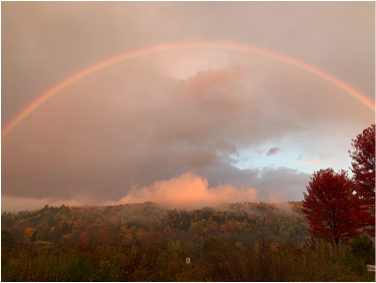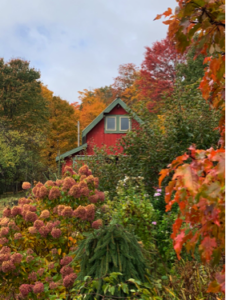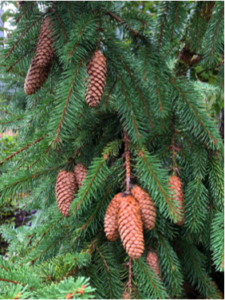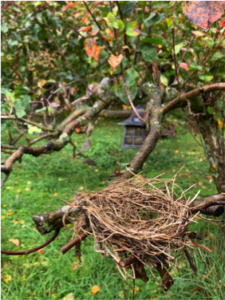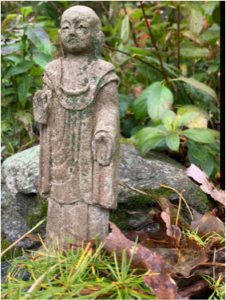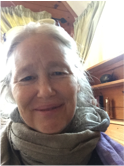Contributed by Laura Ruth
The day is breaking over what may be the peak of the autumn color: gold, peach, deep red, various greens from yellow to black forest glowing in the early morning light. Each day contains many moments, many moods. Unknowns. It is dawn quiet; I have a puppy who needed a little extra loving this morning beside me in the chair by the window. She is so small—only a few pounds—her softness featherweight.
I feel full inside; aware of the bounty and blessing of a single day. A living, vibrational felt-sense of attunement with daybreak, a grand and ordinary movement unfolding. Each little thing is part of it.
I am also exhausted. My body is healing from a year and a half of seemingly all-consuming troubles: no need to make a list. My poor nervous system. I know the day will demand something from me that I may not be sure I have. I do not know how all that is asking to happen will actually manifest in the hours to come. Yet, I feel completely the beauty of the new day, feel it resonating in my bones, budding possibility. Unshakably rooted within—a sense that it will be ok no matter what happens. In that mirror I see what Cynthia calls Mystical Hope.
I experience it as a mystery—that all this belongs, and all the stops along the bridge connecting one pole to the opposing pole, belong. It is sincere, certain. It is true. And so mysterious.
Each time I read Mystical Hope, I find myself struck in a new way by a turn of phrase or Cynthia’s genius relating poignant truth. I appreciate her words when she wades into deeper waters, taking us with her, into territory that most do not attempt to put words to. As in Chapter Four: Dying Before You Die. She identifies the chapter as wanting to talk about “…that hard ground…those situations where the fixing does not occur…” (pg. 58). Where we may find and—truly experience—that Mercy is alive in the very fabric of life, even when all around us is nothing but pain and loss.
This morning I linger on the fullness and the fulfillment in the deep seabed of Mercy: “the final restoration of all things at the end of time” (pg. 63). The wonder that everything is already here, already given, complete in itself as it is. Any given moment already contains all things! When we are engaged in the practices and changes of “dying before we die” we find something of the nature and quality of the end of time is right here and now. What is dying is that which separates us. Through that window, peering over the edge of the alchemical pot we are cooking in, we know that this is true. Time is fuller, immediacy is not urgency, each moment is both fresh and eternal. Alive.
We had a giant jade tree in the corner of our room for a while. It was enormous—growing from a relatively small plant, over time. One year it blossomed. Amazing! Never had seen that before. An extravagant display of simple but beautiful white flowers coming out all over the place. Then it began to drop its branches, one after the other, making piles around the big pot. There was nothing we could do. Eventually, with almost no plant left, the main stem, by then at least three inches thick and only a few inches tall, gently toppled over and there was nothing left but a black hole in its center.
This image arose—along with the memory of little jade plants, tiny by comparison, popping up here and there in the potting soil—out of “dying before we die.” It can be dramatic; more often it is incremental. One step at a time. Stunning, and hard. Lately I have noticed compassion when I am angry at myself. Walking the pole to the flip side of the gesture. Self reproach feels useless, unnecessary. These observations come in the process of the shedding: the dropping of notions of importance or relevance or a singular sense of ‘me’ as something separate. It is challenging in my culture to feel real, simple, equanimous self-including-love. I realize that what I know of that only came after letting ‘me’ go. After bumps and bruises. After all that, I began to include myself in the picture of a whole-world-now. We are adepts at leaving ourselves out of what matters most deeply to us. In the wholeness, completeness and fulfillment of the Mercy it is true: it is all already here. It is simple. More than acceptable, it is as it is. There is nothing to be. To paraphrase Cynthia’s story of the gift her friend Jamien gave her young children on her deathbed: the Mercy carries us buoyantly on into life on a current of love (pg. 68).
In due part the wholeness of life includes inevitable loss, pain, separation, and the distress of things not being what is imagined, or working out at all. I have come to honor that. Sometimes the same regrets that fell away easily last month return with the force of compulsion and have to be wrestled with, again. The fall happens daily in small ways, then sometimes hits like a ton of bricks.
These days I am learning more about the brain and pain in physical therapy: specifically, how the part of the brain that wants to protect us from everyday insult warns us about movements not being safe—to a fault, and for its own purpose. It is all part of how we work with what we’ve got. Moving into and towards the physical pain of injury, we meet the door that opens to the other side of it. Step by step, consciously noticing what is really happening and registering the sensations, and then suddenly the same movement is no longer painful and a sense of core strength grows, emerges. New found energy carries the body in a clearer, focused, stronger movement that has resiliency and power. We do this all the time in lots of different ways. And we run from it.
How do we come to trust the Mercy? In meditation recently, I was in prayer to master teachers Muhammad, Buddha, Lama, Jesus and Moses. Feeling my cry for help—my vulnerability and incapacity in all its tenderness in the moment—deep sobs began rising in my limbs. Simultaneously arising was the recognition that these masters I pray with are all touched by God, and all human beings. They are not separated from God, the veil between them has fallen away. I recognized in that moment how forcefully I separate myself. Humbling, to once again accept and let go.
When Jesus prayed in the garden, his people were sleeping nearby unable to stay awake as he had requested. He felt the wrench alone; the wrestle and the yield. Deeply, beautifully human, the Masters offer us the choice, the hope, to yield as well. Jesus, Cynthia says, “like all the rest of us, must pass through the ground of his own powerlessness and hopelessness. There is to be no hope in the usual sense, no mightily enthroned power to lift up his burdens, He, too, must discover that ‘protecting nearness’ is his own innermost ground” (pg. 73).
It is such a beautiful portrait of life—the protecting nearness of our own innermost ground. Ihidaya, right there, turning in towards the fear that would separate us, and coming through, into the yielding, for all of us. In love. How do we not separate ourselves from the Being that we share? That we are part and parcel of? What is it to return and keep returning? Dying before we die is a series of moments, unfolding in life. Throwing into our personal cauldron the ingredients of the day, our own unique stew—our cycles of life, errors and mistakes, what we cannot stand and what we love. Letting the alchemy work: we cook. Allowing it to work itself in our sensation, in our hearts, in our minds. I don’t think we need to know anything really—perhaps only how to keep turning into it, and allowing, rather than run.
We learn to let go into “the root energy of love sustaining all” (p. 75) through the upheavals and the unexpected, and all we struggle with inside and out. When the cultural stories of what is success and what is failure thin, when our own compulsions soften—it begins. When we deepen our yielding into the Mercy of God and feel the faint fire of inner hope begin to root itself in the dark mystery of the unknown within us: those sparks cannot die. The glimmers, the sensation of knowing, of surrender to “who we are, as we are, in the world, as it is.”*
This is our human miracle. It is an act of trust that our protective brains are loathe to do. But something inside always returns, and as JG Bennet says in his little piece Resurrection: “Even when we do see the helplessness with which we fall into oblivion, at the very moment when we are most trying to hold on to ourselves, we must learn to trust that there is something else that calls us back, and will call us back.” May it be so.
Postscript, September 24, 2024
Coming out of group this morning with my friends and colleagues in the Mystical Hope practice book circle, I sensed that we are indeed weaving a vessel of hope. Chapter One ends with that call to become a vessel, to become a chalice into which this divine energy can pour; a lamp through which it can shine” (pg 17). In Chapter Four we are brought into the depths of life, and offered a tether: that the current of love will carry us on; that if we are willing to let go and yield completely into the Mercy of God, it will take us all the way; that the Mercy, the mystical body of Christ, the body of hope, are all one. It is all the one unknown heart of God flung outward into accessible form, reverberating in our own innermost ground, and in that root energy of sustaining love and the light that drives creation nothing is lost or disappears (pgs 74-75).
In group we find the language to begin to speak of our experience, our challenges and questions, our hopes. We notice: they become more than we are alone; they emerge within us in relationship with one another, with the Wisdom path, and with the greater Whole of which we are all a part. Cynthia quotes Boehme in Chapter One naming “holy substantiality” as “the innermost essence of being itself” (pg. 30). Allowing Mercy to take us, we feel that substance, that sensation of fullness, as it surfaces and grows even within our hour and a half together. It is truly out of time and a ‘body’ beyond space.
It is the vessel we are meant to become; a living current, and just as we assist one another we are assisted by mysteries beyond imagination. We invite one another into that letting go, as we tread round the edge of the great alchemical pot with our denser bits, our hard life teachers, our sudden joys—and the unknown—participating as we may, turning toward, open ear, open heart. Little by little we quiet and wait. And the threads arise, weaving themselves, in a coherent collectivity that we may then allow to take root in our hearts. We have been touched and are held. We pay attention. The touch of ‘holy substantiality’ may quiet, brighten, and fade, as we walk with it into our days, but it will never be lost.
*See the Babette Lightner verse in her exercise Wholeness in Motion led by Heather Ruce here on the Wisdom Waypoints website.
**See Cynthia’s Holy Week Liturgies in the section “Wednesday Vespers: Anointing Ceremony.” Or check out the JG Bennett Foundation here for this and other terrific resources.
Laura is dedicated to an embodied, practical Wisdom, awake and alive in daily life in her inner life and outer work, whether it is in her one-with-one private practice or with the Wisdom Waypoints Living Wisdom groups and book circles. She is a member of the Wisdom Waypoints Council, and was Community Program Coordination and Publishing staffperson until June 2021 all of which cultivated in her a particular love for the Wisdom community. Laura lives in Vermont on the land of the Abenaki people, with her dear husband, near their sons, two grandchildren and her mother.
Mystical Hope Wisdom Practice Book Circle 2022
These writings were part of a monthly series of reflections contributed by participants and leaders in the Wisdom Practice Book Circle exploring Mystical Hope: Trusting in the Mercy of God by Cynthia Bourgeault.


